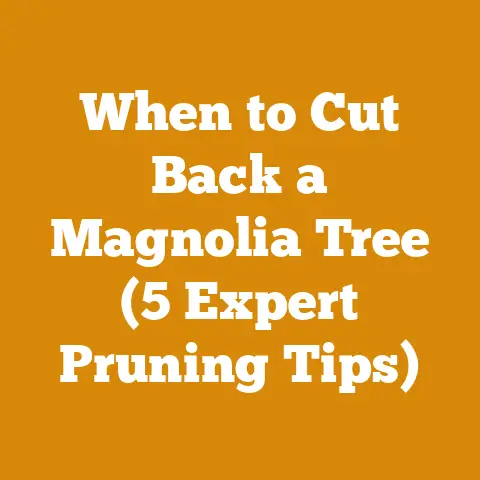Pruning a Japanese Maple Tree (5 Pro Arborist Tips for Precision)
Alright, buckle up, buttercups!
We’re diving headfirst into the delicate art of pruning Japanese Maple trees.
Now, I know what you’re thinking: “Chainsaw expert pruning a maple?
Isn’t that like using a sledgehammer to crack a walnut?” Well, not exactly.
Precision is precision, whether you’re felling a giant oak or shaping a delicate Acer palmatum.
And believe me, after decades of wrestling with wood, I’ve learned a thing or two about respect for trees of all sizes.
So, let’s trade the roar of the chainsaw for the snip of the pruners and get started.
Pruning a Japanese Maple Tree: 5 Pro Arborist Tips for Precision
Japanese Maples.
Just the name conjures images of serene gardens, vibrant autumn colors, and delicate, lacy leaves.
These trees are prized for their beauty, but like any living thing, they need a little help to thrive.
Pruning is that help, and when done right, it can enhance the tree’s natural form, promote healthy growth, and even extend its lifespan.
But fear not!
This guide will walk you through the process.
1. Understanding the Art of Japanese Maple Pruning
Pruning Japanese Maples isn’t just about hacking away random branches.
It’s about understanding the tree’s natural growth habit and working with it, not against it.
My grandfather, a seasoned logger, always said, “Listen to the wood, and it’ll tell you what it needs.” The same principle applies here.
- Why Prune? The primary reasons for pruning are to remove dead, diseased, or damaged branches, improve air circulation and sunlight penetration within the canopy, shape the tree to enhance its aesthetic appeal, and control its size.
When to Prune? The best time to prune Japanese Maples is during the dormant season, typically late winter or early spring before new growth begins.
This allows the tree to heal quickly and focus its energy on new growth.
Avoid pruning in late summer or early fall, as this can stimulate new growth that won’t have time to harden off before winter.- My Experience: I once pruned a Japanese Maple in late October (against my better judgment, I confess) because the homeowner insisted.
The result?
Tender new shoots that were promptly nipped by the first frost.
Lesson learned! -
Understanding Growth Habits: Japanese Maples have a variety of growth habits, from upright and vase-shaped to weeping and cascading.
Knowing your tree’s specific growth habit is crucial for making informed pruning decisions. -
Pro Tip: Take a good look at your tree from all angles before you even pick up your pruners.
Visualize the shape you want to achieve and identify any problem areas. -
Essential Tools:
-
Hand Pruners: For small branches (up to ½ inch diameter).
Look for bypass pruners, which make cleaner cuts than anvil pruners. - Loppers: For larger branches (up to 1 ½ inch diameter).
Loppers provide more leverage than hand pruners. - Pruning Saw: For branches larger than 1 ½ inch diameter.
A folding pruning saw is a good option for portability. - Gloves: To protect your hands from thorns and sap.
- Eye Protection: Safety glasses are a must to protect your eyes from flying debris.
-
Ladder (if needed): Use a sturdy ladder and follow proper safety precautions.
-
Tool Maintenance: Keep your tools sharp and clean.
Dull tools can tear bark and make it harder for the tree to heal.
I always sharpen my pruning tools after each use.
It’s a small investment of time that pays off in the long run.
- My Experience: I once pruned a Japanese Maple in late October (against my better judgment, I confess) because the homeowner insisted.
Sanitation: Clean your pruning tools with a solution of 1 part bleach to 9 parts water before and after pruning each tree to prevent the spread of disease.
- Why it Matters: I once witnessed a whole orchard succumb to a fungal disease because the pruners weren’t properly sanitized.
Don’t let that happen to your precious Japanese Maple!
- Why it Matters: I once witnessed a whole orchard succumb to a fungal disease because the pruners weren’t properly sanitized.
Takeaway: Pruning is about understanding your tree and working with it.
Choose the right tools, sanitize them religiously, and prune at the right time for optimal results.
2. The Pro Arborist’s Pruning Techniques
Now that you have a solid foundation, let’s get into the nitty-gritty of pruning techniques.
These are the techniques that separate the amateurs from the pros.
Thinning Cuts: Thinning cuts remove entire branches back to their point of origin or to a lateral branch.
This opens up the canopy, improves air circulation, and allows more sunlight to reach the inner branches.- How to do it: Identify the branch you want to remove.
Locate the branch collar (the swollen area where the branch joins the trunk or another branch).
Make a clean cut just outside the branch collar, avoiding cutting into the collar itself. - Why it Matters: Cutting into the branch collar can damage the tree’s natural defense mechanisms and make it more susceptible to disease.
- How to do it: Identify the branch you want to remove.
Heading Cuts: Heading cuts shorten a branch by cutting it back to a bud or lateral branch.
This encourages new growth and can be used to control the shape of the tree.
However, heading cuts can also create dense, unnatural growth if not done properly.- How to do it: Choose a bud or lateral branch that is pointing in the direction you want the new growth to grow.
Make a clean cut about ¼ inch above the bud or branch, angling the cut slightly away from the bud. - When to Avoid: I generally avoid heading cuts on Japanese Maples unless absolutely necessary.
They can disrupt the tree’s natural form and create unsightly “witches’ brooms” of dense growth.
- How to do it: Choose a bud or lateral branch that is pointing in the direction you want the new growth to grow.
Removing Dead, Diseased, or Damaged Branches: This is the most important reason to prune.
Dead, diseased, or damaged branches can harbor pests and diseases that can spread to the rest of the tree.
They also detract from the tree’s overall appearance.- How to do it: Remove these branches back to healthy wood.
If the branch is diseased, make sure to sanitize your pruning tools after each cut to prevent the spread of the disease. - My Rule of Thumb: If you see something that doesn’t look right, cut it out.
It’s better to be safe than sorry.
- How to do it: Remove these branches back to healthy wood.
Crossing and Rubbing Branches: These branches can rub against each other, creating wounds that can become infected.
Remove one of the branches to eliminate the rubbing.- Which to Remove? Generally, remove the weaker or less desirable branch.
Consider the overall shape of the tree and choose the branch that will best enhance its form.
- Which to Remove? Generally, remove the weaker or less desirable branch.
Suckers and Water Sprouts: Suckers are shoots that grow from the base of the tree or from the roots.
Water sprouts are shoots that grow straight up from the branches.
Both suckers and water sprouts are unproductive and can detract from the tree’s appearance.
Remove them as soon as you see them.- How to Remove: Cut them off flush with the trunk or branch.
Over-pruning can stress the tree and make it more susceptible to pests and diseases.- My Approach: I always start by removing only the dead, diseased, or damaged branches.
Then, I step back and assess the tree’s overall shape before making any further cuts.
- My Approach: I always start by removing only the dead, diseased, or damaged branches.
Takeaway: Master the art of thinning cuts and heading cuts, and always prioritize the removal of dead, diseased, or damaged branches.
3.
Shaping for Beauty and HealthShaping a Japanese Maple is about enhancing its natural form and creating a visually appealing tree.
It’s an art form, and like any art form, it takes practice and a good eye.-
Identifying the Natural Form: Before you start shaping, take some time to study your tree’s natural form.
Is it upright, weeping, or cascading?
What are its dominant characteristics?- My Tip: Look at pictures of mature Japanese Maples of the same variety to get an idea of what the tree should look like.
-
Enhancing the Natural Form: The goal of shaping is to enhance the tree’s natural form, not to force it into an unnatural shape.
Use thinning cuts to open up the canopy and reveal the tree’s beautiful structure.- Example: If you have a weeping Japanese Maple, use thinning cuts to remove some of the inner branches and create a more graceful, cascading effect.
-
Creating Balance and Symmetry: Aim for a balanced and symmetrical shape.
This doesn’t mean that the tree has to be perfectly symmetrical, but it should look visually balanced from all angles.- How to Achieve Balance: Step back from the tree frequently and assess its shape from different perspectives.
Use thinning cuts to remove branches that are throwing off the balance.
- How to Achieve Balance: Step back from the tree frequently and assess its shape from different perspectives.
-
Opening Up the Canopy: A dense canopy can block sunlight and air circulation, creating a humid environment that is conducive to disease.
Use thinning cuts to open up the canopy and allow more sunlight and air to reach the inner branches.- The “Sunlight Test”: Imagine the sun shining through the tree.
You should be able to see dappled sunlight reaching the ground beneath the tree.
- The “Sunlight Test”: Imagine the sun shining through the tree.
-
Addressing Specific Problems:
- Leggy Growth: If the tree has long, bare branches with foliage only at the tips, it’s said to have “leggy” growth.
This can be caused by insufficient sunlight or over-crowding.
Use heading cuts to shorten the branches and encourage new growth closer to the trunk. - Dense Growth: If the tree has a dense, congested canopy, it can block sunlight and air circulation.
Use thinning cuts to remove some of the inner branches and open up the canopy. - One-Sided Growth: If the tree is growing more vigorously on one side than the other, it can look lopsided.
Use thinning cuts to remove some of the branches on the more vigorous side and encourage growth on the less vigorous side.
- Leggy Growth: If the tree has long, bare branches with foliage only at the tips, it’s said to have “leggy” growth.
-
Patience is Key: Shaping a Japanese Maple is a process that takes time.
Don’t try to achieve the perfect shape in one pruning session.
Instead, make small, incremental adjustments over time.- My Philosophy: I prefer to prune a little bit each year rather than doing a major pruning every few years.
This is less stressful for the tree and allows me to maintain its shape more easily.
- My Philosophy: I prefer to prune a little bit each year rather than doing a major pruning every few years.
Takeaway: Shaping is about enhancing the tree’s natural beauty and promoting its health.
Take your time, be patient, and make small, incremental adjustments over time.4.
Common Mistakes and How to Avoid ThemEven the most experienced pruners make mistakes from time to time.
The key is to learn from those mistakes and avoid repeating them.
Here are some of the most common mistakes people make when pruning Japanese Maples, and how to avoid them.-
Over-Pruning: This is the most common mistake.
Over-pruning can stress the tree and make it more susceptible to pests and diseases.- The Solution: Remember the “less is more” philosophy.
Start by removing only the dead, diseased, or damaged branches.
Then, step back and assess the tree’s overall shape before making any further cuts. - My Personal Experience: I once pruned a Japanese Maple too heavily, thinking I was doing it a favor.
The tree responded by sending out a flush of weak, spindly growth.
It took several years for the tree to recover.
- The Solution: Remember the “less is more” philosophy.
-
Topping: Topping is the indiscriminate removal of the top of the tree.
This is a terrible practice that can ruin the tree’s natural form and make it more susceptible to disease.- The Solution: Never top a Japanese Maple.
Instead, use thinning cuts to open up the canopy and heading cuts to control the size of the tree. - Why it’s Bad: Topping stimulates the growth of numerous weak, upright shoots that are prone to breaking.
It also creates large wounds that are slow to heal.
- The Solution: Never top a Japanese Maple.
-
Leaving Stubs: Leaving stubs when pruning can create entry points for pests and diseases.
- The Solution: Make clean cuts just outside the branch collar, avoiding cutting into the collar itself.
- The “Branch Collar Rule”: The branch collar is the swollen area where the branch joins the trunk or another branch.
This area contains specialized cells that help the tree heal after pruning.
-
Using Dull Tools: Dull tools can tear bark and make it harder for the tree to heal.
- The Solution: Keep your pruning tools sharp and clean.
I always sharpen my pruning tools after each use. - Sharpening is Key: A sharp tool makes a clean cut, which heals faster and is less susceptible to disease.
- The Solution: Keep your pruning tools sharp and clean.
-
Pruning at the Wrong Time: Pruning at the wrong time can stress the tree and make it more susceptible to pests and diseases.
- The Solution: Prune Japanese Maples during the dormant season, typically late winter or early spring before new growth begins.
- Timing is Everything: Pruning during the dormant season allows the tree to heal quickly and focus its energy on new growth.
-
Neglecting Sanitation: Not sanitizing your pruning tools can spread diseases from one tree to another.
- The Solution: Clean your pruning tools with a solution of 1 part bleach to 9 parts water before and after pruning each tree.
- Prevention is Better Than Cure: It’s much easier to prevent the spread of disease than it is to treat it.
Takeaway: Avoid these common mistakes by following the principles outlined in this guide.
Remember to prune conservatively, use sharp tools, and sanitize them religiously.5.
Post-Pruning Care: Ensuring a Healthy RecoveryPruning is just the first step.
Proper post-pruning care is essential to ensure that your Japanese Maple recovers quickly and thrives.-
Watering: Water the tree deeply after pruning, especially if the weather is dry.
This will help the tree recover from the stress of pruning.- The “Deep Watering” Technique: Water the tree slowly and deeply, allowing the water to soak into the soil around the roots.
-
Fertilizing: Fertilize the tree in the spring with a slow-release fertilizer formulated for Japanese Maples.
This will provide the tree with the nutrients it needs to grow and thrive.- Fertilizer Choice: Look for a fertilizer that is high in phosphorus and potassium, which are essential for root development and overall plant health.
- My Fertilizer Recommendation: I prefer a slow-release fertilizer because it provides a steady supply of nutrients over a long period of time.
-
Mulching: Apply a layer of mulch around the base of the tree to help retain moisture, suppress weeds, and regulate soil temperature.
- Mulch Type: Use organic mulch, such as shredded bark or wood chips.
Avoid using rock mulch, as it can heat up the soil and stress the tree. - Mulch Depth: Apply a layer of mulch that is 2-4 inches deep.
Keep the mulch a few inches away from the trunk of the tree to prevent rot.
- Mulch Type: Use organic mulch, such as shredded bark or wood chips.
-
Monitoring for Pests and Diseases: Keep an eye on the tree for signs of pests or diseases.
If you see anything unusual, take action immediately.- Common Pests: Aphids, spider mites, and scale are common pests of Japanese Maples.
- Common Diseases: Verticillium wilt and anthracnose are common diseases of Japanese Maples.
- Early Detection is Key: The sooner you detect a pest or disease problem, the easier it will be to treat.
-
Protecting from Sun and Wind: Newly pruned Japanese Maples can be more susceptible to sun and wind damage.
If the tree is located in a particularly sunny or windy spot, consider providing some temporary protection.- Sun Protection: Use shade cloth to protect the tree from direct sunlight.
- Wind Protection: Use a windbreak to protect the tree from strong winds.
-
Patience is Still Key: It takes time for a tree to recover from pruning.
Be patient and continue to provide the tree with the care it needs.- My Final Thought: Pruning is an ongoing process.
Continue to monitor the tree and make small adjustments as needed.
- My Final Thought: Pruning is an ongoing process.
Takeaway: Proper post-pruning care is essential for ensuring that your Japanese Maple recovers quickly and thrives.
Water, fertilize, mulch, and monitor for pests and diseases.
And remember, patience is key.So, there you have it!
My pro arborist tips for pruning Japanese Maple trees.
It might seem like a daunting task at first, but with a little knowledge and practice, you can keep your Japanese Maple looking its best for years to come.
Now, go forth and prune with confidence!
And remember, if all else fails, you can always call a professional.
But where’s the fun in that?- How to Remove: Cut them off flush with the trunk or branch.






